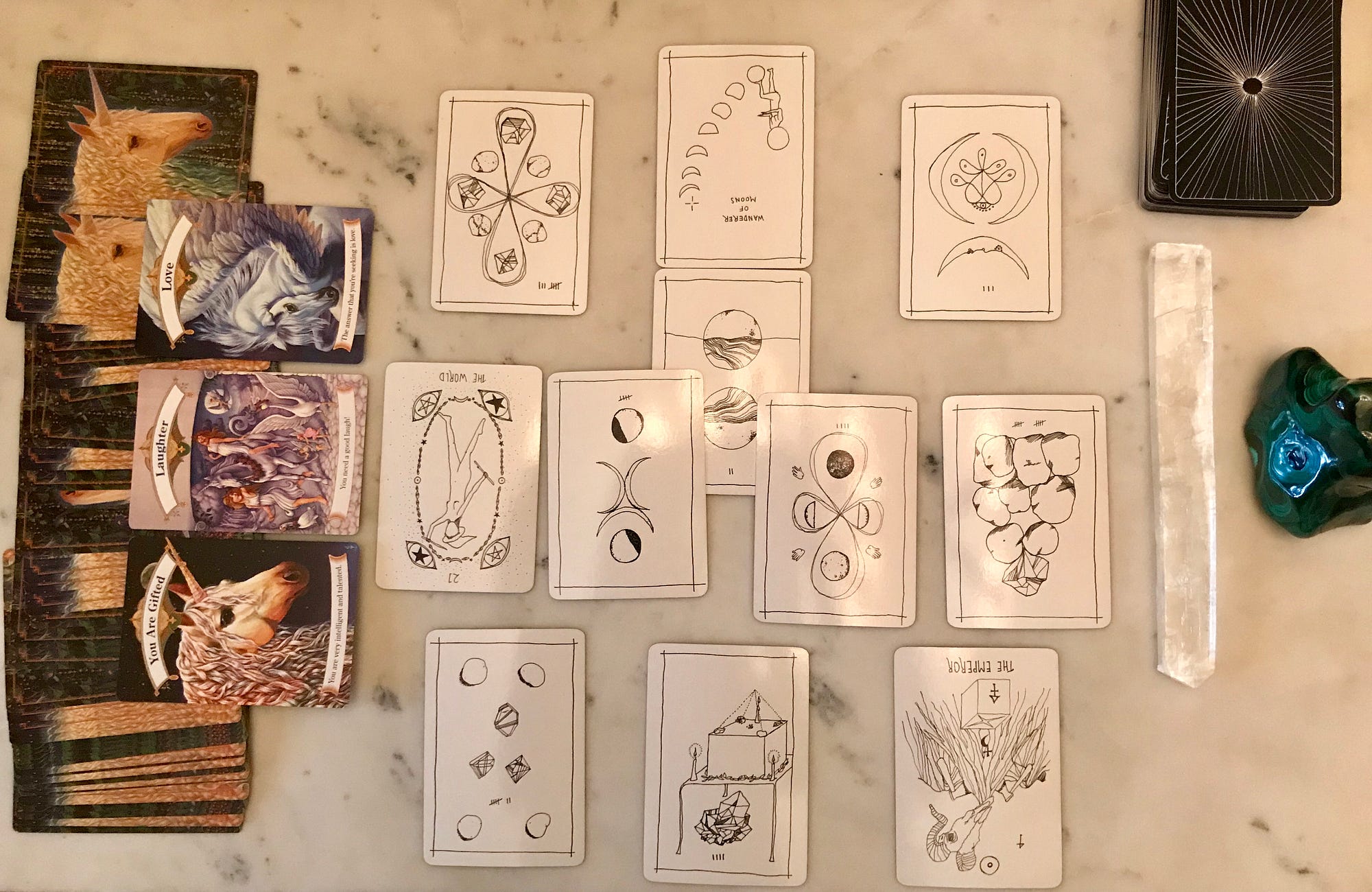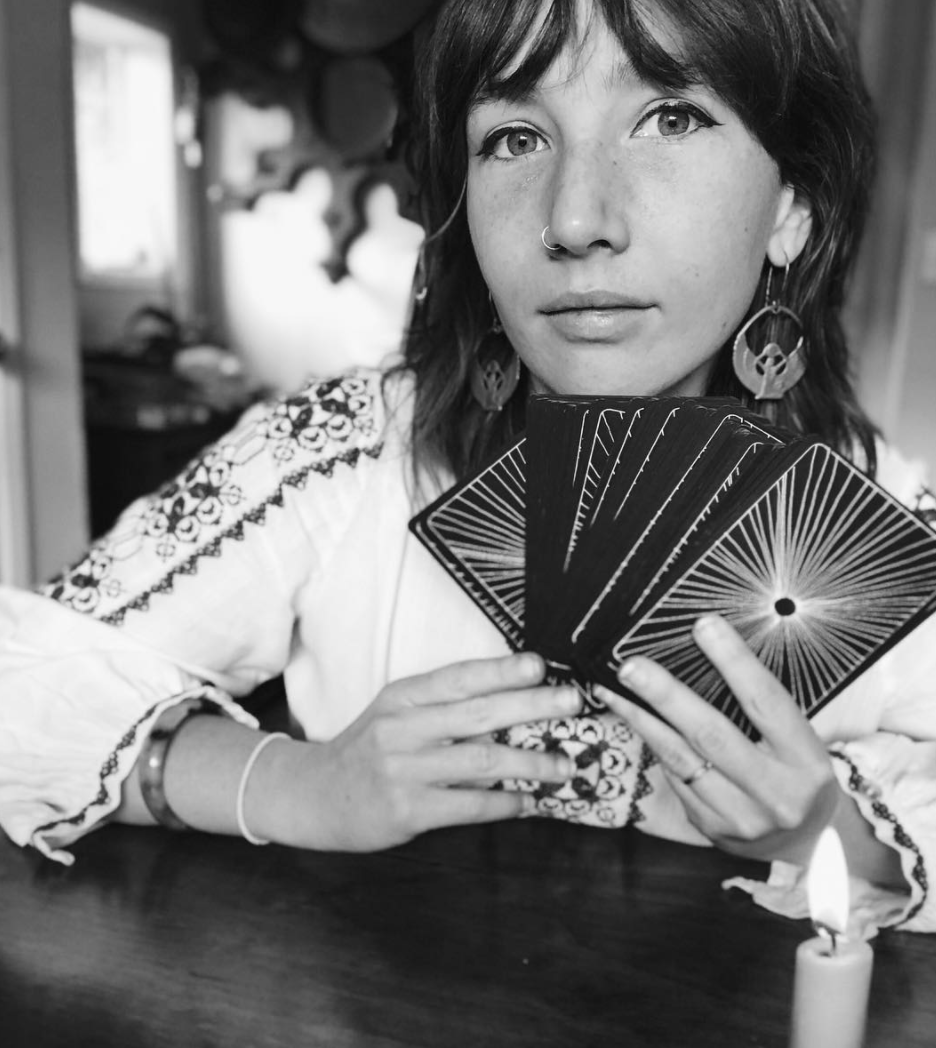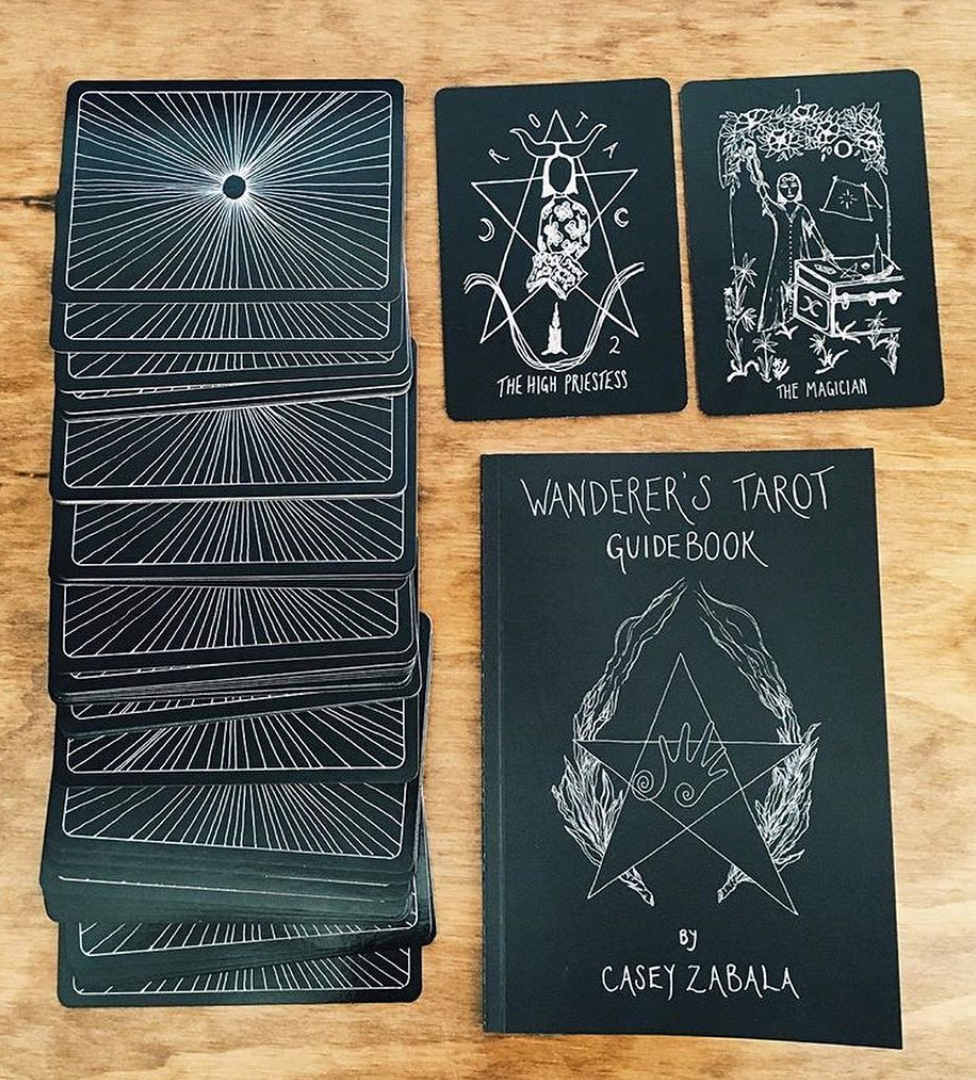
I’ve never been much for magic tricks. As a kid, I greeted any displays of sleight of hand with squinty-eyed skepticism and requested, “Do it again! But slower, so I can watch.”
I’ve never believed in ghosts — or spirits or chakras either. I listened to my horoscope only if it promised that a cute stranger would enter into the picture. And I definitely didn’t trust tarot.
In my mind, tarot was something women did to find out when they would finally fulfill their life’s potential, watch their dreams come true…and get married. And for a low, low price of $20 (cash or money order only), somehow, whatever curse was plaguing their career or relationships would be magically and mystically lifted.
So when I made an appointment with Casey Zabala (a.k.a. The Wanderer’s Tarot), it was in some ways perfectly in the cards and also totally against them. To me, tarot had always seemed more naive than empowering — waiting for someone else to tell you when your life will be. But as a single lady who occasionally (give or take 25 times a day) wonders when she’ll find “The One,” I figured there was nothing to lose in trying something besides another swipe on Bumble.
Despite my reservations, Zabala—who considers herself a witch because she uses crystals and tracks the moon’s phases — paid my roommate and me a house call last week. Her energy was calm and watchful, and she looked like a gal I would run into on the bus: mid-20s, nose ring, her fingers adorned with silver and stones. She wore distressed Levi’s and a surplus jacket and carried a straw bag containing large stone crystals—airy pinks and turquoises.

Immediately, she got to work setting up her workspace in our living room, carefully removing a tarot deck from her bag — a gorgeous, illustrative deck she crafted by hand. Zabala started reading tarot (which she pronounced “tuh-roh” but insisted that it can be said either way) when she was 13 after receiving a deck as a gift from a friend of her mother. A self-described intuitive and emotional kid, she became enraptured by the stories she could tell and the relationships she could forge through the cards. I felt weirdly nervous but excited, like how I’ve felt before a big trip or a first date—the next few moments would be entirely new.
I had read up on tarot before Zabala arrived, but I needed to analyze it myself first before it analyzed me. Most historians agree that tarot first originated in the early 15th century. In a letter from the Duke of Milan, the royal requested “triumph” cards to play at an upcoming event. The cards, with their four suits, numbers one through 10, and face cards like kings and pages, came to be used in the royal court for a game similar to modern-day bridge. Soon, the game spread from Italy to other parts of Europe, catching the eyes of mystics, witches and astrologers. For them, the suits and symbols reflected hidden meanings, and they’ve become associated with divination ever since.
As is the case with many modern-day innovations, tarot essentially originated from a man’s desire to be entertained. The cards were formulated in a traditionally patriarchal fashion, with the king being the highest card and the imagery on tarot decks featuring men in various positions of power throughout the court. But women were the ones who brought the cards to life, according to Zabala, through their illustrations and interpretations. As she grew acquainted with tarot and adopted the medium as her own, Casey was sick of practicing with cards that didn’t represent over half of her clients.
So she created her own deck by hand, one that swaps kings for “wanderers,” wands for “feathers” and male bodies for female ones. The result is a beautiful, rich set of feminist tarot cards.

As I sat on the the floor across from her, she dealt me 11 cards in alternating rows of three, four and three — with one card in the middle on top. The sketches on my cards looked at once promising and also as though they might predict an untimely death.
In tarot, each card inherently holds a different meaning, whereby moons (or cups) tend to describe emotional substance, and stones (or pentacles) deal in the economic. A card’s position on the table can reflect a different point of interpretation, so that a certain card’s meaning changes on the basis of where it is dealt (and who the subject may be). Face-up, face-down and neighboring cards can also reflect a specific significance.
Before diving in, Casey asked if I’d like to set an intention for the reading. “Do I have to?” I asked, careful not to disrupt fate in action. She said that I didn’t. Yet as soon as all the cards were dealt (Casey peppering in an occasional “huh” and “wow”), she opened with the question “Are you in a relationship?”
I told her that I wasn’t and that I wasn’t really seeing anyone special at the moment. No one unspecial, either. She was surprised, because the first card she pulled, the Two of Moons, was the “soulmate” card. Interesting, indeed. Usually, she said, that card represents lifetime partnership or romantic love. I assured her that there really wasn’t a soulmate in my actual real-world cards at the moment. She suggested that the card could also reflect my own personal harmony. A love of the self. I’m down with that.
Throughout the remainder of the cards, a theme of disappointment and apathy emerged — as well as a need for structure in my life.
Most illuminating is The World, a card that depicts a naked woman encircled by a string of stars, which appeared on my outside column. It’s about feeling centered in life — whereby things flow and feel synchronous. But mine was upside down.
We mused on this for a moment. Casey asked me if I ever feel stagnant. I felt a tug in my gut. This struck home.
Here’s the thing. My life is good. I live in San Francisco, a city of beautiful people and even more beautiful dogs. I have family close by, good friends I can lean on, a job that challenges me and a home that feels safe. I don’t feel ungrateful for it, but I have an overarching feeling of wanting more.
More of what, exactly, I’m not sure. Casey arrived at the word before I did: “intention.”
The Wanderer of Moons propped up the bottom row of my spread, and she looked a bit unusual. A female body and a circular head ascend stepping stones of a waxing moon, until the last sliver disappears into a glimmer. It’s captivating. As one of the more emotional cards in the deck, the Wanderer of Moons implores us to expand and explore our feelings. She asks us to wander outside of our comfort zones—to feel more, achieve more, be more.
The cards seemed to be telling me—telling Casey—that I am rudderless, traveling through life without a North Star. They sensed a stagnation of progress, an existence of comfort that might be a little too easy. They wanted me to have fun (the Three of Moons smiled at me from the corner), to explore, to do something and to wander, but ultimately to live my life with a purpose—a reason.
Now, to be clear, this wasn’t one of those Hollywood medium moments in which I was shocked that Casey could know all this because “I’ve never told anyone before!” what I had just told her, right then. We talked about it.
But where we arrived was a new place, one that gave me hope and also homework. I knew what I needed to do — and that felt different from before. At that moment, we were two women discussing the future and our smorgasbord of options. We said to ourselves, “Look at all you can do, all that this life can bring. What do you want to do with it?” We’re not waiting for anyone to tell us. That to me is power. We are the new kings.”
I guess that’s the thing about tarot. It’s not about predicting the future but about helping us see it in a new light. No matter what the cards actually say, it’s what we take from them and where we go from there that matters.
The next morning, after my reading, I boarded the 5R and grabbed my usual seat. My routine was unchanged, and momentarily I forgot that I had just drunk kombucha with a witch. But I felt clear-headed, enlightened about what my life might lack and what I wanted to change. I guess I can thank the cards for that.







